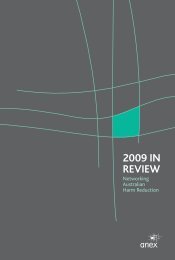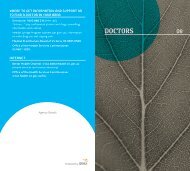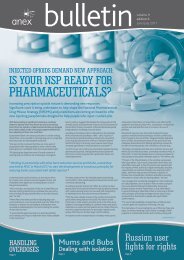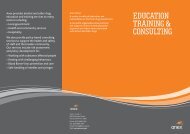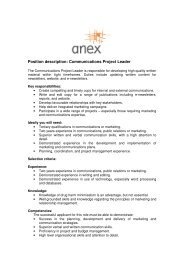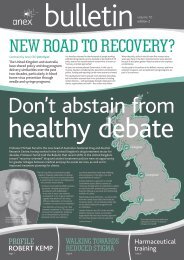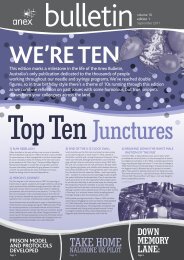Fact sheet â Syringe Vending Machines - Anex
Fact sheet â Syringe Vending Machines - Anex
Fact sheet â Syringe Vending Machines - Anex
You also want an ePaper? Increase the reach of your titles
YUMPU automatically turns print PDFs into web optimized ePapers that Google loves.
fact <strong>sheet</strong><br />
<strong>Syringe</strong><br />
<strong>Vending</strong><br />
<strong>Machines</strong><br />
What are <strong>Syringe</strong><br />
<strong>Vending</strong> <strong>Machines</strong>?<br />
<strong>Syringe</strong> <strong>Vending</strong> <strong>Machines</strong><br />
(SVMs), also known as syringe<br />
dispensing machines, are selfcontained<br />
units that hold and<br />
supply sterile injecting equipment.<br />
There are several styles and<br />
models. They are usually nondescript<br />
metallic units that stand<br />
alone or are wall-mounted.<br />
Unlike snack vending machines<br />
or cigarette machines, they do<br />
not advertise their contents.<br />
Why are SVMs used?<br />
SVMs are a key part of the public health<br />
response to reducing blood borne virus<br />
(BBV) transmission associated with injecting<br />
drug use. They do this by increasing access<br />
to sterile injecting equipment. They may be<br />
installed in areas where:<br />
• It is not possible to establish a staffed<br />
Needle and <strong>Syringe</strong> Program (NSP) and/or<br />
staffing resources may be scarce.<br />
• It has been identified that some current<br />
injecting drug users (IDUs) may not<br />
otherwise access staffed NSPs.<br />
Where are SVMs used?<br />
SVMs have been installed in 84 locations in<br />
New South Wales, since first being trialled<br />
in 1992. They have now been introduced<br />
in Queensland, the ACT, Western Australia<br />
and Tasmania. 1 They are also used in<br />
New Zealand and a number of European<br />
countries. 1<br />
In Australia, they have been placed where<br />
it is not possible to establish staffed NSP<br />
outlets, or to supplement existing services.<br />
They may be located at or near hospital<br />
campuses or fixed NSP sites, and in areas<br />
of high drug use. 1<br />
How do SVMs work?<br />
Internationally, there are a number of<br />
different models of SVMs. Some operate at<br />
no cost or operate with tokens. Some charge<br />
a minimal amount. Others provide new<br />
equipment in exchange for used equipment,<br />
or have the capacity to accept disposals.<br />
Mobile units are available, which can be<br />
moved outside of a service, locked in place,<br />
and operate while the service itself is closed.<br />
Other models can be turned on and off to<br />
operate during certain hours only.<br />
Typically SVMs dispense packs containing<br />
sterile injecting equipment and a small<br />
disposal container. Packs dispensed can also<br />
include swabs, spoons, water ampoules,<br />
condoms, wheel (pill) filters and educational<br />
materials.<br />
In Australia, disposal facilities are usually<br />
located adjacent to the machines.<br />
What has happened in areas where SVMs<br />
have been trialled or implemented?<br />
The ACT trial of four vending machines in<br />
2005-2006 was evaluated by an external<br />
consultant. The evaluation found: 2<br />
• No media coverage (positive or negative),<br />
including letters to the editor, other than<br />
in ACT Health publications and other<br />
health agency newsletters.<br />
• One person wrote two letters to the<br />
Minister of Health suggesting that<br />
more information about the dangers of<br />
injecting and available social supports<br />
for IDUs should be provided through the<br />
SVMs.<br />
• SVMs did not reduce the number of<br />
contacts of people who go to fixed site<br />
NSPs, where education and referral<br />
services can be provided.<br />
1 2<br />
1 Newer wall-mounted model trialled in the ACT.<br />
2 SVM at Kirketon Road Centre in NSW, one of<br />
the oldest machines in Australia, piloted in 1992.
• In addition to increasing after hours<br />
access for regular NSP service users, SVMs<br />
were successful in reaching IDUs that do<br />
not normally attend fixed site NSPs, such<br />
as younger IDUs and women.<br />
• There were very few incidents of<br />
inappropriately disposed equipment<br />
in the immediate vicinity of SVMs.<br />
• No increase in heroin overdoses or the<br />
number of ambulance call-outs during<br />
the trial.<br />
Based on the evaluation findings, ACT<br />
Health has agreed to continue the use<br />
of SVMs with ongoing monitoring.<br />
“<br />
In Queensland four SVMs were trialled at<br />
hospitals in four regional towns in 2005-<br />
2006. The evaluation of the trial found: 3<br />
• No increase in unsafe disposal.<br />
• No reported incidents or formal<br />
complaints during the trial from<br />
emergency department (ED) staff, police,<br />
community or other stakeholders.<br />
• Limited and benign media coverage, none<br />
of which was in response to community<br />
concerns or incidents.<br />
• No reduction in access to fixed site NSPs<br />
where education and referral is available.<br />
• A reduction in the equipment provided<br />
by ED staff.<br />
• After hours access was the most<br />
important feature for IDUs followed by<br />
the anonymity of the service.<br />
The SVMs were discreetly located either on<br />
the hospital grounds or within the hospital,<br />
and monitored by CCTV or health staff.<br />
Based on the evaluation findings, SVMs<br />
have been installed in additional locations.<br />
There are now eight SVMs operating in<br />
Queensland with 10 more planned for<br />
installation.<br />
In New South Wales SVMs were first<br />
trialled in 1992. The evaluation identified<br />
improved accessibility to sterile injecting<br />
equipment for IDUs. It recommended<br />
that SVMs should continue to be used.<br />
Consequently, SVMs have since become<br />
an integral part of the State’s public health<br />
SVMs have not detracted from IDUs accessing staffed<br />
NSPs, but rather have been found to be one part of<br />
an effective range of strategies to minimise the harms<br />
arising from drug use.<br />
”<br />
program. Today there are 101 SVMs at 84<br />
different locations. They are usually located<br />
at existing primary or secondary NSPs or at<br />
hospitals or community health centres.<br />
Although concerns and objections at the<br />
introduction of SVMs were submitted<br />
prior to their introduction, many of the<br />
anticipated problems were not experienced. 5<br />
Few, if any, complaints were received by<br />
community members upon installation.<br />
What are the limitations of SVMs?<br />
Operational malfunctions have been the<br />
main limitation identified in the SVM<br />
trials. 2,3 This resulted in difficulties in<br />
accessing sterile injecting equipment<br />
until the machine was fixed. However,<br />
improvements to the machines by<br />
manufacturers 2 and clear operating<br />
protocols to ensure timely repairs 3 have<br />
been implemented to address these<br />
issues. Modifications have also been used<br />
to address instances of vandalism of the<br />
machines (purportedly to access equipment<br />
or money contained within). 2<br />
There may be some concern that SVMs<br />
will increase inappropriately discarded<br />
equipment. However, evidence from trials<br />
in Australia reveal that this is not the case. 2<br />
The experience of dispensing sterile injecting<br />
equipment through SVMs has also shown<br />
that they are accessed by their intended<br />
audience (i.e. IDUs). A range of strategies<br />
have been implemented to decrease the<br />
likelihood that general members of the<br />
public, including children, will access the<br />
machines. These include the non-descript<br />
design of the machines, placement of<br />
machines in discreet locations and targeted<br />
promotion of SVMs.<br />
Finally, SVMs have not detracted from IDUs<br />
accessing staffed NSPs, but rather have been<br />
found to be one part of an effective range<br />
of strategies to minimise the harms arising<br />
from drug use. 6 These strategies must also<br />
include skilled NSP workers, drug treatment<br />
options and effective law enforcement.<br />
1) Islam MM & Conigrave KM (2007). Assessing the role of<br />
syringe dispensing machines and mobile van outlets in reaching<br />
hard-to-reach and high-risk groups of injecting drug users<br />
(IDUs): a review. Harm Reduction Journal, 4(14), pp. 1-27.<br />
2) McDonald D (2007). ACT syringe vending machines trial<br />
2005-2006. Siggins Miller & David Miller, Social Research &<br />
Evaluation. Canberra, ACT<br />
3) Queensland Government (2006). Evaluation Report: Afterhours<br />
needle and syringe dispensing machine pilot project.<br />
Queensland Government, Queensland Health, Brisbane, QLD.<br />
4) Berg R (1993). Needle and syringe vending machine trial<br />
evaluation report 1: Metropolitan locations. NSW Department<br />
of Health, Sydney, NSW.<br />
5) Baxter, T (2005). <strong>Syringe</strong>-dispensing machines – a KRC<br />
perspective. <strong>Anex</strong> Bulletin, 3(2), p.5.<br />
6) Islam MM, Stern T, Conigram KM & Wodak A (2008).<br />
Client satisfaction and risk behaviours of the users of syringe<br />
dispensing machines: a pilot study. Drug and Alcohol Review, 27,<br />
pp. 13-19.<br />
www.anex.org.au<br />
<strong>Anex</strong> (2008) <strong>Fact</strong> Sheet: <strong>Syringe</strong> <strong>Vending</strong> Machine. <strong>Anex</strong>: Melbourne, VIC<br />
This project has been supported with a General Grant from the<br />
Victoria Law Foundation – www.victorialawfoundation.org.au



